United Productions of America (U.P.A.) was a prominent animation studio in the 1950s and 1960s known for its bold graphics and distinctive flat style of design. The studio got a contract from Columbia Pictures in 1948 to produce theatrical cartoons.
Unlike other animation studios who concentrated on anthropomorphic “funny animals” characters, the stars of U.P.A. were human: the near-sighted Mr. J. Quincy Magoo and Gerald McBoing-Boing, the boy who never spoke in words but in sound effects.
Mr. Magoo’s first appearance was in the theatrical short Ragtime Bear (1949) where he mistakes a bear for his raccoon coated nephew, Waldo. That first short, written by Millard Kaufman, was directed by John Hubley, an innovative animator who had earlier worked at the Disney studio. Columbia hesitated to release the short and only did so because it featured a bear who they assumed was the star of the cartoon.
Supposedly, Hubley originally based the character on a bullheaded uncle of his named Harry Woodruff who could not be convinced he was wrong once he had made a snap judgment. The comedian W.C. Fields was another influence.
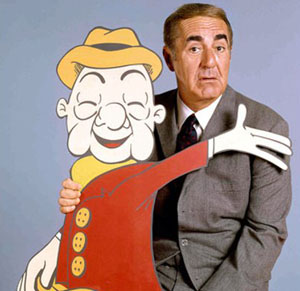 Jim Backus, who was hired to provide the voice for the character, saw elements of his own father in the character, a man who was almost personally isolated from the rest of the world.
Jim Backus, who was hired to provide the voice for the character, saw elements of his own father in the character, a man who was almost personally isolated from the rest of the world.
Backus claimed, “Magoo’s voice was taken from the character I play in my nightclub act — the man in the club car [the train car where alcohol can be purchased]. You know, the loud-mouth traveling salesman who shows pictures of his family to everybody in the club car, belongs to all the clubs and tells dirty jokes. It was the same with Magoo in the beginning. He was a dirty old man. Half the time you couldn’t understand what he was saying; he just used to mumble.”
Despite Backus’ success in other areas including his visibility as the millionaire Thurston Howell III on the popular television series Gilligan’s Island, he was always haunted by the fame of Magoo. He said, “I’d like to bury the old creep and get some good dramatic roles in movies. He is a pain in the posterior. Every time I start to be a serious actor I lose out because someone – usually a producer – says I’m Magoo.”
Yet despite those often repeated feelings, Backus for many years drove around Hollywood with the license plate “Q MAGOO” and kept performing the character.
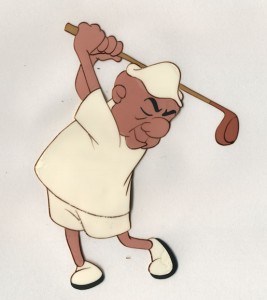 In a 1978 interview, Backus said, “Magoo has been very good to me but I certainly don’t think of him as myself. He is a pain in the posterior.
In a 1978 interview, Backus said, “Magoo has been very good to me but I certainly don’t think of him as myself. He is a pain in the posterior.
“We made up a complete biography for the little jerk. He graduated from Rutgers. He’s a card-carrying Republican and was on the Committee to Re-elect William McKinley. The only thing left to do is an X-rated Magoo picture.”
According to UPA President Hank Saperstein, “Well, he was definitely East Coast and he was Ivy League but I knew Harvard and Yale weren’t quite right. Then it came to me in a flash! Rutgers!”
Rutgers is the state university of New Jersey and during the period when Magoo would have attended (officially determined to be Class of 1928) it was unaffiliated with any league or conference. Its principal athletic rivals are, however, the Ivy League schools of Princeton and Columbia.
Of course, when Saperstein stated this fact, he had just unveiled sketches for a proposed Magoo feature film which recounted the myopic hero’s early days at Rutgers as a football hero.
Rutgers Magazine finding no connection between the creators of Mr. Magoo or actor Jim Backus to the university stated UPA wanted Magoo to be “a college alumnus who was still fired up with the old school spirit, and [they felt] Rutgers was the embodiment of the ‘old school tie’ in America.”
In the Mr. Magoo short Trouble Indemnity (1950), a fly-by-night insurance salesman is able to sell the nearsighted old man a big bogus policy but only after getting Rutgers clothes and accessories out of Magoo’s closet and convincing him he is “Roy Rutgers, insurance salesman”. Rutgers is also featured prominently in Magoo’s Homecoming (1959).

Henny Backus was the wife of Backus and they were married in 1943 and wrote several books together. She provided the voice of Quincy’s mother, Mother Magoo, who was in her late Eighties and raced cars but still had to endure the misguided attentions of her son who thought she was a helpless old woman. Henny did the original voice in the cartoon Meet Mother Magoo (1956). Voice actress June Foray later took over the role.
Henny remembered, “Magoo, according to Jim, is a raunchy, lecherous, ultra- conservative, mildly racist, skirt chasing, old bastard. We’ve always felt that an X-rated Magoo, done with a bit of taste, would be a blockbuster. Can you imagine that nearsighted old curmudgeon mistaking a house of ill repute for a car wash?
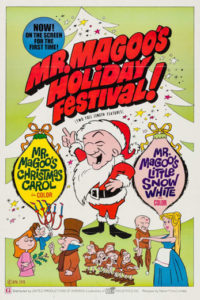 “Jim was in the 1952 film Don’t Bother to Knock with Marilyn Monroe. He came home one night during the filming and told me that Miss Monroe in her most seductive breathy voice asked him to meet her in her dressing room. His curiosity got the better of him and he went. Once there, she exclaimed like an excited child, ‘Do Mr. Magoo!’ And Jim did.”
“Jim was in the 1952 film Don’t Bother to Knock with Marilyn Monroe. He came home one night during the filming and told me that Miss Monroe in her most seductive breathy voice asked him to meet her in her dressing room. His curiosity got the better of him and he went. Once there, she exclaimed like an excited child, ‘Do Mr. Magoo!’ And Jim did.”
In 1977, as their Christmas card, Backus and Henny sent out celluloids of animated legend Mr. Magoo from the then new series, What’s New, Mr. Magoo with a handwritten holiday message.
Mr. Magoo appeared in his own feature film 1001 Arabian Nights in 1959, the incredible 1962 television holiday special Mr. Magoo’s Christmas Carol and three TV series (the syndicated Mr. Magoo Show, the NBC primetime series The Famous Adventures of Mr. Magoo, and the CBS Saturday morning show What’s New, Magoo?)
Henry G. Saperstein, President of UPA Pictures Inc. wrote a fiery letter to the Los Angeles Times that was published October 25, 1993 in response to an article by Rob Wishart, ”A Word to Disney: Pass Up Rights to ‘Mr. Magoo’.” that had appeared in the L.A. Times Calendar section October 16, 1993:
“Mr. Magoo is myopic, but so is 52% of the U.S. Wishart ‘sees’ Magoo as a pathetic buffoon. Yet, Magoo films have been honored by the motion picture academy, the New York Museum of Modern Art, the Kennedy Center, the Los Angeles County Museum of Art and many others.
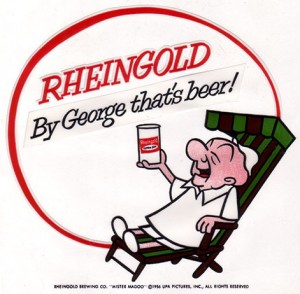 “He’s been a very successful spokesman for GE, RCA, Timex, Blue Shield, NutraSweet, the U.S. Treasury, the U.S. Navy, the American Cancer Society, the National Safety Council and the American Heart Association.”
“He’s been a very successful spokesman for GE, RCA, Timex, Blue Shield, NutraSweet, the U.S. Treasury, the U.S. Navy, the American Cancer Society, the National Safety Council and the American Heart Association.”
Because of attacks that Magoo was disrespectful to the visually challenged, the 1997 live action film featuring Leslie Nielsen in the role was pulled after two weeks in the theaters. Interestingly, when the Magoo cartoons first were released, it was reported that Walt Disney said, “How long can one actually look at Magoo’s antics.”
In a mid-1960s essay, animator and director Chuck Jones wrote,
“In animation, it became unfashionable and a little shameful to animate in the great tradition and animators found little pride in their craft and no innovations of animation worthy of note are to be found in the so-called UPA school.
“It is an odd kind of indictment of the failure of this great opportunity that the only surviving UPA character still in public demand is Mr. Magoo and Mr. Magoo was the only UPA character in the 1930 tradition: shave Grumpy of the Seven Dwarfs and you have Mr. Magoo.
“Mr. Magoo was also a truly animated character because you understood what he was by what he did, not by what he said he did, or by what someone else—usually a narrator—said he did.”


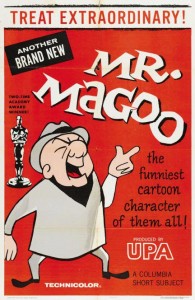
 Jim Korkis is an internationally respected animation historian who in recent years has devoted his attention to the many worlds of Disney. He was a columnist for a variety of animation magazines. With his former writing partner, John Cawley, he authored several animation related books including The Encyclopedia of Cartoon Superstars, How to Create Animation, Cartoon Confidential and Get Animated’s Animation Art Buyer’s Guide. He taught animation classes at the Disney Institute in Florida as well as instructing classes on acting and animation history for Disney Feature Animation: Florida.
Jim Korkis is an internationally respected animation historian who in recent years has devoted his attention to the many worlds of Disney. He was a columnist for a variety of animation magazines. With his former writing partner, John Cawley, he authored several animation related books including The Encyclopedia of Cartoon Superstars, How to Create Animation, Cartoon Confidential and Get Animated’s Animation Art Buyer’s Guide. He taught animation classes at the Disney Institute in Florida as well as instructing classes on acting and animation history for Disney Feature Animation: Florida.




















































Strange that Jim Backus and his wife both thought an X-rated Mr. Magoo picture would be a good idea. I understand that actors and their spouses get up to a certain amount of role-playing in their private lives, but that’s something I don’t even want to think about.
I enjoyed watching the Mr. Magoo cartoons on TV when I was little, but even then I preferred him as Ebenezer Scrooge, or Long John Silver, or Merlin, or Noah — that is, as anyone BUT Magoo. “How long can one actually look at Magoo’s antics?” In my case, not very. In his 1993 letter to the Times, Henry Saperstein omitted to mention that all of Magoo’s honours and endorsements had happened decades in the past. There was no real demand for a revival of the character, and it was clear to me at the time that the Disney feature was one of those movies that periodically get made purely to keep a trademark from expiring. Come to think of it, by my reckoning we might be due for another unwarranted Magoo reboot. I just hope this one isn’t pornographic.
Oh, Magoo, you’ve done it. Now never do it again.
They already rebooted Magoo back in 2019 for another TV series on Paramount+. At the very least, the show seems to replicate the banality of the original UPA series for modern audiences.
Of course, if that’s not your style you can always seek out the 2010 feature film “Kung Fu Magoo”, which is somehow an actual product and not a schlocky parody you’d find on a bad sketch show.
Thanks for the tip. I just saw a couple episodes of the 2019 Magoo series and was surprised at how much I liked it.
I think, and hope, they meant X-Rated in the old fashioned more generalised sense of adults only, i.e. profane (and perhaps discriminatory) language.
That does seem like what the Backuses were talking about, especially given Henny’s comment: “We’ve always felt that an X-rated Magoo, done with a bit of taste, would be a blockbuster. Can you imagine that nearsighted old curmudgeon mistaking a house of ill repute for a car wash?” That definitely sounds like an idea that would be developed along the lines of titillation rather than outright pornography.
I’m surprised Ralph Bakshi didn’t take him up on the X-rated Magoo idea.
Pity that they never mentioned the fort named after him….https://militarybases.com/california/point-mugu/
Always a special high to see a theatrical Magoo. TY!!!!!
I’m not sure the Leslie Nielsen film was pulled out of theatres due to the controversy, such as it was, so much as the obvious reason that it wasn’t making money. The most interesting thing about the film is it the only Western film directed by Stanley Tong, known for his work in Hong Kong with Jackie Chan, particularly Supercop and Chan’s US breakthrough Rumble in the Bronx.
“The Famous Adventures”, despite one of the all-time great title sequences, is a fascinating misfire.
Magoo as Scrooge dispensed with the nearsighted schtick except in the backstage opening and near the end of the show, but his curmudgeonliness (although soft-pedaled by the later theatricals and the syndicated show) was a perfect fit. “Famous Adventures” followed that model, except that Magoo was now plopped into classic stories he did NOT fit. Add to this that the show was produced on a tight budget and schedule; that heavy plots had to fit a half hour less commercials and comic bookends; and that they inexplicably decided to do it STRAIGHT, eschewing comedy and deploying Magoo as a serious actor. One wonders if it was conceived as a UPA showpiece without Magoo, then turned into a Magoo vehicle when the TV special was a hit.
I believe the Magoo character could have survived losing the eyesight gimmick. He was vividly obnoxious; Hubley, Backus & co. nailed a type everybody knew and enjoyed seeing caricatured. He was perfectly capable of causing mayhem purely through orneriness and iron-clad wrongness. When they tweaked him to be “lovable”, he would still wreak havoc on Waldo and other hapless victims with the unshakable conviction he was doing them grand favors.
I think “Don Quixote” worked quite well with Magoo considering the title character (matter of fact, UPA was planning to make that their theatrical vehicle for Magoo before deciding on “Arabian Nights”). I just wish this version would have songs like “Christmas Carol”. Although, “Man of La Manchia” debut shortly after the series ended.
IMHO “What’s New Mr Magoo?” had a great theme song, but I don’t recall anything else about the show itself.
My wife’s great grandfather drew all of those Mr Magoo cartoons. Her parents recently past away and we found all of his original drawings. We did find an X rated drawing of Mr Magoo. I’m sure it was never seen. Maybe by Backus.